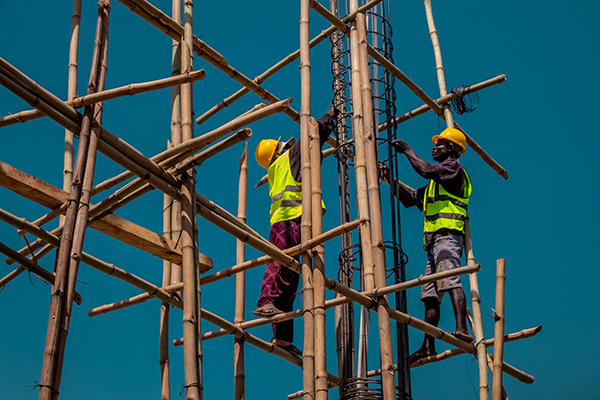Construction projects face budget and schedule risks. Data-driven RMIS solutions help contractors predict issues and stay on track.
By Adrian Pellen and Tyler James
General contractors (GC) and owner/developers tasked with building commercial and residential property are always faced with a set of risks that can impact the outcome of their projects, whether it’s going over budget, running behind schedule or navigating natural disasters. However, there is a market solution at the intersection of data, project management and the construction sector that addresses the challenge of harnessing risk related data to help ensure that projects are delivered on schedule and within budget. The solution, a Risk Management Information System (RMIS), is used to aggregate, analyze and manage risk-related data, thus ensuring projects come in on time and budget.

Although RMIS’ are not new to insurance and risk management, its application in the construction sector is not yet widespread. Given the complexities of the construction industry, executives know the importance of advanced risk management systems for acquiring and managing risk data. Unfortunately, many industry stakeholders are not well equipped to capture critical data about issues on their projects and as a result are not well positioned to make better informed decisions regarding their commercial and risk management strategy.
The construction industry faces unique challenges that make traditional risk management approaches insufficient. Projects often span multiple years, involve numerous subcontractors, and operate in dynamic environments where weather, regulatory changes, and supply chain disruptions can significantly impact outcomes. Without proper construction risk management systems in place, contractors frequently find themselves reacting to problems rather than preventing them.
For construction industry executives, an RMIS can be used to track the progress of items such as claims, incident reporting and loss control, enterprise risk, and policy management issues. Additionally, the tool can assist in the efficient management of contracts and assets, crucial for maintaining operational efficiency and cost-effectiveness in construction projects. These comprehensive RMIS capabilities enable stakeholders to optimize their risk management strategies, ensuring safer, compliant, and more profitable construction operations.
The power of RMIS construction industry applications extends beyond basic risk tracking. Modern systems can monitor worker safety metrics in real-time, track equipment maintenance schedules to prevent breakdowns, and analyze weather patterns to optimize construction schedules. For instance, an RMIS can alert project managers when certain weather conditions increase the likelihood of accidents, allowing them to adjust work schedules proactively.
Contract management represents another critical area where RMIS delivers value. Construction projects typically involve dozens of contracts with various parties, each carrying specific risk profiles. A robust RMIS can track contract terms, monitor compliance requirements, and flag potential disputes before they escalate into costly legal battles. This capability becomes particularly valuable in complex projects where contract interdependence can create cascading risks.
Not only can RMIS capture and organize project data, but it can also offer useful insights, forecasting potential threats before they happen. RMIS are powered by real-time analytics and predictive models so risk managers can proactively identify patterns and trends, allowing them to take preventative action before an incident occurs and turns into a costly claim. While construction executives directly benefit from streamlining operations and reducing incidents, the adoption of an RMIS and implementation of a data architecture strategy can streamline the risk assessment and the insurance underwriting processes as well.
In addition, the data harnessed through a well-structured RMIS can be used to identify and implement risk control strategies that, through engagement with insurers, can drive more competitive policy terms, leading to a tangible reduction in the total cost of risk (TCOR) of projects.
Construction project data analytics capabilities within modern RMIS platforms can process vast amounts of information from multiple sources simultaneously. These systems integrate data from IoT sensors monitoring structural integrity, GPS tracking systems following equipment movements, and environmental sensors measuring air quality and noise levels. By analyzing this comprehensive dataset, RMIS can identify subtle patterns that human observers might miss.
While the utilization of a RMIS offers numerous advantages, its implementation is not without challenges. During the application, construction executives can encounter issues including resistance to change from employees, integration challenges, and training difficulties. There can also be data gaps. For example, RMIS implementations typically only capture activity associated with incidents or claims. A common data integration gap includes not capturing both exposure and claims data together, which allows for better insights by undertaking an analysis of losses based on asset class, project delivery method and other factors.
The construction sector also happens to be in a new phase of digitization with the explosion of Large Language Models (LLMs) and Generative Artificial Intelligence (AI). As technology continues to address various construction challenges, stakeholders can begin launching a RMIS as a first step to building out their own decision-making data architecture. By ensuring construction project exposure and claims data is structured and standardized, stakeholders can facilitate seamless integration with LLMs and AI platforms, which can help builders make more informed decisions, thereby gaining a competitive edge in the market. Integrating the insights derived from a RMIS with LLMs, AI platforms and other cutting-edge technologies not only closes the data gap but also unlocks a new realm of possibilities for predictive analytics, strategic planning, and the development of new risk management and mitigation techniques in the construction industry.
The last decade has seen a technological revolution in the built world. These changes have reaffirmed the importance of deploying risk control technologies to mitigate risks on construction projects. The confluence of RMIS, project management, reality capture and the Internet of Things (IoT), powered by artificial intelligence (AI), are paving the way for an era of transparency and awareness in a time of projects reaching unprecedented complexity, scope and scale.
Adopting these technologies means breaking down data silos and facilitating a seamless flow of information to create a healthier project risk profile and consequently a significant reduction in TCOR. These elements provide the data architecture so that construction executives can harness insights from their data and deploy risk mitigation strategies that help ensure projects are completed on time and on budget.
The construction industry stands at a critical juncture where traditional risk management approaches are no longer sufficient to address modern project complexities. Organizations that embrace RMIS technology and integrate it with emerging AI capabilities will gain significant competitive advantages through improved project outcomes, reduced costs, and enhanced safety performance. The future belongs to those who can effectively leverage data to transform construction risk management from a cost center into a strategic differentiator.
About the Authors:

Adrian Pellen is Managing Director and Co-leader, Construction and Infrastructure Group at NFP.

Tyler James is Senior Vice President Construction Property Broking Leader at NFP.
In this episode, I sat down with Beejan Giga, Director | Partner and Caleb Emerson, Senior Results Manager at Carpedia International. We discussed the insights behind their recent Industry Today article, “Thinking Three Moves Ahead” and together we explored how manufacturers can plan more strategically, align with their suppliers, and build the operational discipline needed to support intentional, sustainable growth. It was a conversation packed with practical perspectives on navigating a fast-changing industry landscape.